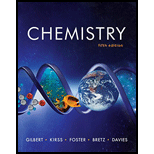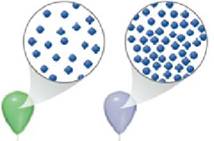
Interpretation: The balloons are given to be inflated at the same temperature to the same volume. More gas is given to be needed in inflating the balloon depicted on the right side. The balloon in which gas is under greater internal pressure and the balloon having a greater entropy value are to be identified.
Concept introduction: Entropy is a
Internal pressure is defined as the pressure acting within the system from a gas or liquid inside the system at a constant temperature.
To determine: The balloon in which gas is under greater internal pressure and the balloon having a greater entropy value.
Answer to Problem 17.1VP
Solution
The balloon on the right contains gas under greater internal pressure.
The balloon on the left contains the gas that has greater entropy.
Explanation of Solution
Explanation
The Figure is given below.

Figure 1
Two balloons are inflated at the same temperature to the same volume as shown in the above Figure, though it takes more gas to inflate the balloon on the right.
In the above Figure, the balloon on the right with purple color has molecules which are in close contact with each other. This happens only in the case of the high internal pressure.
So, balloon on the right contains gas under greater internal pressure.
In the above Figure, the balloon on the left with green color has molecules which are moving freely as they are apart from each other inside the balloon. There is more randomness of the molecules inside the balloon due to which entropy is high.
So, the balloon on the left contains gas that has greater entropy.
Conclusion
The balloon on the right contains gas under greater internal pressure.
The balloon on the left contains the gas that has greater entropy
Want to see more full solutions like this?
Chapter 17 Solutions
Chemistry: The Science in Context (Fifth Edition)
 ChemistryChemistryISBN:9781305957404Author:Steven S. Zumdahl, Susan A. Zumdahl, Donald J. DeCostePublisher:Cengage Learning
ChemistryChemistryISBN:9781305957404Author:Steven S. Zumdahl, Susan A. Zumdahl, Donald J. DeCostePublisher:Cengage Learning ChemistryChemistryISBN:9781259911156Author:Raymond Chang Dr., Jason Overby ProfessorPublisher:McGraw-Hill Education
ChemistryChemistryISBN:9781259911156Author:Raymond Chang Dr., Jason Overby ProfessorPublisher:McGraw-Hill Education Principles of Instrumental AnalysisChemistryISBN:9781305577213Author:Douglas A. Skoog, F. James Holler, Stanley R. CrouchPublisher:Cengage Learning
Principles of Instrumental AnalysisChemistryISBN:9781305577213Author:Douglas A. Skoog, F. James Holler, Stanley R. CrouchPublisher:Cengage Learning Organic ChemistryChemistryISBN:9780078021558Author:Janice Gorzynski Smith Dr.Publisher:McGraw-Hill Education
Organic ChemistryChemistryISBN:9780078021558Author:Janice Gorzynski Smith Dr.Publisher:McGraw-Hill Education Chemistry: Principles and ReactionsChemistryISBN:9781305079373Author:William L. Masterton, Cecile N. HurleyPublisher:Cengage Learning
Chemistry: Principles and ReactionsChemistryISBN:9781305079373Author:William L. Masterton, Cecile N. HurleyPublisher:Cengage Learning Elementary Principles of Chemical Processes, Bind...ChemistryISBN:9781118431221Author:Richard M. Felder, Ronald W. Rousseau, Lisa G. BullardPublisher:WILEY
Elementary Principles of Chemical Processes, Bind...ChemistryISBN:9781118431221Author:Richard M. Felder, Ronald W. Rousseau, Lisa G. BullardPublisher:WILEY





